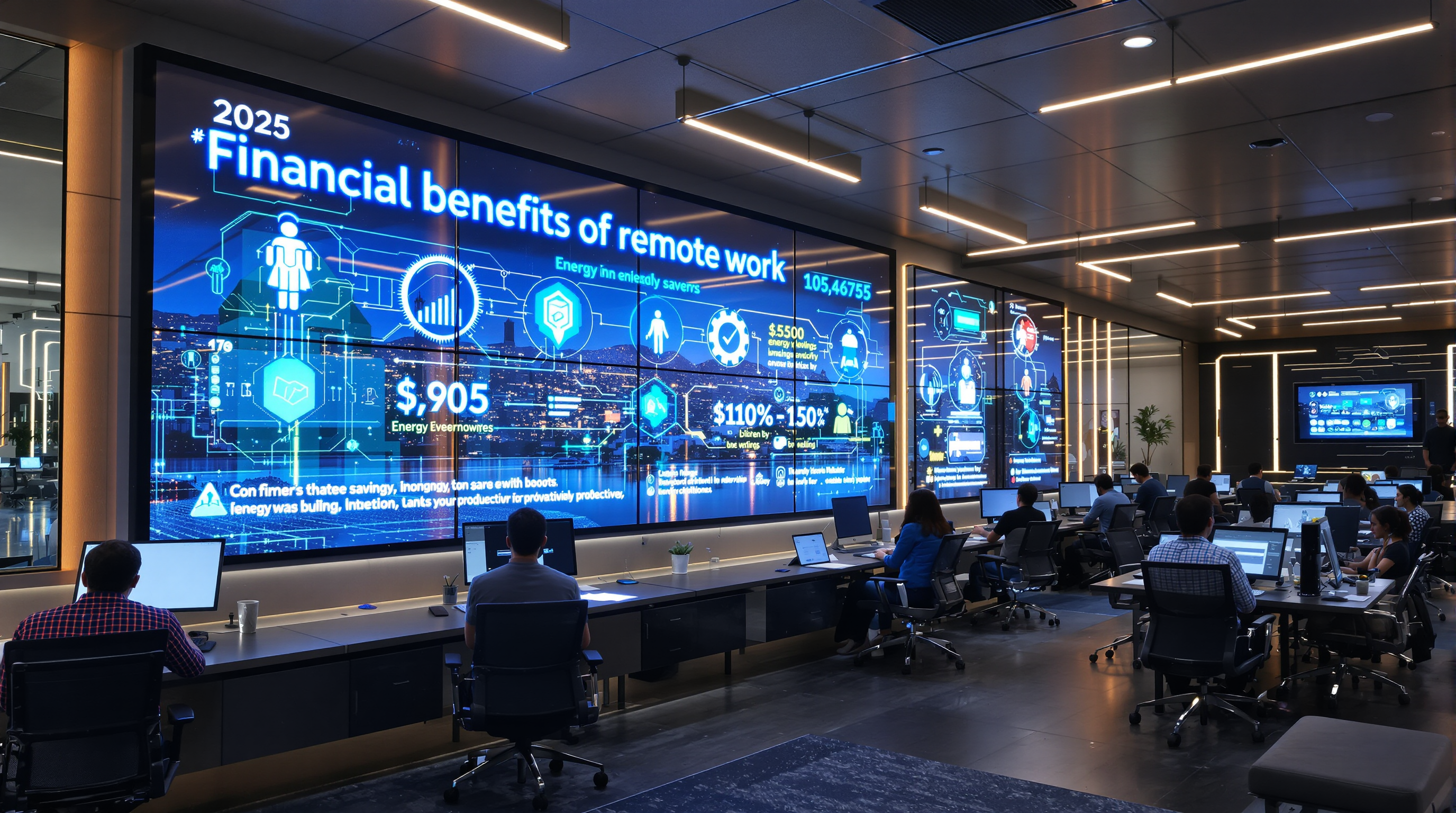The Financial Implications of Remote Work Trends in 2025

As we navigate through 2025, the landscape of work has undergone a profound transformation, with remote work emerging as a dominant trend that reshapes not only how we work but also the financial dynamics of businesses and economies worldwide. The COVID-19 pandemic acted as a catalyst, accelerating the adoption of remote work practices that were already gaining traction. Now, as we settle into a new normal, it is crucial to understand the multifaceted financial implications of remote work trends in 2025. This comprehensive analysis delves into the economic shifts, challenges, and opportunities that accompany this new era of work, providing detailed insights and practical examples to illustrate the complexities of this evolving landscape.
Real Estate and Urban Economic Impact
The shift towards remote work has triggered significant changes in real estate markets and urban economic structures. With the decrease in demand for commercial office space, US office vacancy rates have surged to nearly 20% in early 2025, with tech hubs like Austin experiencing rates exceeding 25%. This decline in office space demand has led to a corresponding increase in the demand for residential properties equipped for home offices, creating a ripple effect across the real estate sector.
For instance, consider a mid-sized tech company based in San Francisco that has transitioned to a fully remote work model. Prior to the shift, the company leased a 50,000 square foot office space in the heart of the city, incurring substantial costs for rent, utilities, and maintenance. With the adoption of remote work, the company has downsized its office space to a 10,000 square foot co-working space, resulting in annual savings of approximately $2 million. These savings have been reinvested into employee development programs, cutting-edge technology, and enhanced cybersecurity measures, positioning the company for long-term success.
However, the reduction in office space demand has not been uniformly distributed across all markets. While some cities are experiencing a surge in vacancies, others are witnessing a steady demand for office space, particularly in industries that require in-person collaboration, such as finance and healthcare. For example, New York City has seen a more moderate increase in office vacancies, with rates hovering around 15%, as many financial institutions have maintained a hybrid work model, requiring employees to be present in the office for part of the week.
The decline in office space demand has also had a profound impact on urban economic structures, particularly in cities that have historically relied on commuter-driven tax revenue. Philadelphia, for instance, has experienced a substantial decline in wage tax revenue, as many employees have relocated to neighboring states with lower tax rates. To address this challenge, the city has implemented a series of fiscal reforms, including targeted tax incentives for businesses that maintain a physical presence in the city and investments in infrastructure projects aimed at attracting new businesses and residents.
Moreover, the shift to remote work has led to a reconfiguration of urban spaces, with a growing demand for co-working spaces, community centers, and mixed-use developments that cater to the needs of remote workers. For example, cities like Barcelona and Amsterdam have seen a surge in the development of co-working spaces and innovation hubs, providing remote workers with access to collaborative workspaces, networking opportunities, and professional development resources. These developments have not only revitalized urban economies but have also fostered a sense of community and connection among remote workers.
Business Financial Benefits and Challenges
Companies that have embraced flexible remote work policies are reaping notable financial benefits. According to recent studies, companies that offer fully flexible remote work options have experienced a 21% industry-adjusted revenue growth from 2020 to 2022, compared to a mere 5% growth for companies that have adopted hybrid or on-site-only models. The financial advantages extend beyond revenue growth, with remote work contributing to a 13% boost in employee performance and an additional $2,000 in profit per remote employee. Furthermore, companies with remote work policies have reported a 26% lower turnover rate, translating to substantial savings in recruitment and training costs.
For example, consider a software development company based in Seattle that has adopted a fully remote work model. By embracing remote work, the company has been able to tap into a global talent pool, hiring skilled developers from countries such as India, Ukraine, and Argentina at a fraction of the cost of hiring locally. This strategic approach has not only resulted in significant cost savings but has also enhanced the company's competitive advantage by enabling it to deliver high-quality products and services to clients around the world.
However, the transition to remote work is not without its challenges. Businesses must navigate the complexities of tax compliance and expense reporting. Neglecting to properly track and report remote worker expenses can result in serious financial consequences. Moreover, the evolving tax regulations surrounding remote work require businesses to stay informed and adapt their strategies to avoid costly errors. The multi-state payroll and tax nexus issues add another layer of complexity, necessitating careful management and strategic planning.
Consider a multinational corporation with employees working remotely across multiple states and countries. To ensure compliance with tax regulations, the company must establish a clear understanding of the tax laws in each jurisdiction and implement a robust system for tracking and reporting remote worker expenses. Failure to do so could result in significant penalties and legal complications, underscoring the importance of proactive tax planning and compliance management.
Furthermore, businesses must also address the challenges of managing remote teams, including communication, collaboration, and performance management. To overcome these challenges, companies must invest in technology, training, and clear policies that support remote work. For instance, a marketing agency based in Chicago has implemented a comprehensive remote work policy, including regular check-ins, clear performance metrics, and ongoing training and support, ensuring that remote workers are equipped to deliver exceptional service to customers.
Cost Savings for Remote-First Companies
Companies that have adopted a remote-first model are realizing significant cost savings, with an estimated $11,000 saved per employee annually. These savings stem from reduced office lease costs, utilities, and facilities maintenance. By reinvesting these savings into employee wellbeing, technology, and training, remote-first companies are enhancing their organizational resilience and positioning themselves for long-term success in an increasingly volatile global economy.
For instance, a marketing agency based in Chicago has transitioned to a remote-first model, resulting in annual savings of approximately $1.5 million. These savings have been allocated to employee development programs, such as online courses, certifications, and coaching, as well as investments in cutting-edge marketing technology and cybersecurity measures. By prioritizing employee growth and organizational resilience, the company has been able to attract and retain top talent, fostering a culture of innovation and continuous improvement.
Moreover, remote-first companies are also benefiting from reduced turnover rates, with studies showing that remote workers are more likely to stay with their employers for longer periods. For example, a customer service call center based in Dallas has seen a 30% reduction in turnover rates since adopting a remote-first model, resulting in significant savings in recruitment and training costs. By providing employees with the flexibility and autonomy to work remotely, the company has been able to create a more engaged and satisfied workforce, ultimately driving business success.
Workforce and Productivity Insights
Remote work continues to gain traction, with approximately 28% of the global workforce working remotely by 2023, and the trend is expected to continue into 2025. In the United States, 22.8% of employees were working remotely as of mid-2024. The productivity of remote workers has generally remained stable or improved, with remote options significantly boosting employee retention and recruitment. However, the benefits of remote work are not evenly distributed, with higher-earning, educated workers more likely to benefit from remote work opportunities, while service-sector jobs remain largely location-bound, exacerbating income inequality.
For example, consider a customer service call center based in Dallas that has transitioned to a hybrid work model, allowing employees to work remotely for part of the week. While this approach has resulted in improved employee satisfaction and retention, the company has also faced challenges in maintaining consistent service quality and managing remote worker performance. To address these issues, the company has implemented a comprehensive performance management system, including regular check-ins, clear performance metrics, and ongoing training and support, ensuring that remote workers are equipped to deliver exceptional service to customers.
Furthermore, the shift to remote work has also highlighted the importance of digital literacy and access to technology. Companies must ensure that their employees have access to the necessary tools and resources to perform their jobs effectively, including high-speed internet, laptops, and software applications. For instance, a non-profit organization based in Detroit has partnered with local internet service providers to offer discounted internet access to its employees, ensuring that they have the necessary resources to work remotely and serve the organization's mission.
Environmental Impact
The shift to remote work has also had a positive impact on the environment. Reduced commuting has contributed to a notable decrease in greenhouse gas emissions, with the potential to reduce emissions by up to 54 million tons annually if telework-compatible roles do so half the time. The improvements in air quality during peak travel hours are a testament to the environmental benefits of remote work, highlighting the potential for remote work to contribute to global sustainability goals.
For instance, consider a consulting firm based in London that has adopted a remote work policy, allowing employees to work from home for up to three days per week. By reducing the number of commutes, the company has contributed to a significant decrease in greenhouse gas emissions, as well as improvements in air quality and traffic congestion. Moreover, the company has implemented a series of sustainability initiatives, such as virtual meetings and paperless documentation, further enhancing its environmental impact and aligning with global sustainability goals.
Moreover, the shift to remote work has also led to a growing demand for sustainable and energy-efficient homes, as employees seek to create comfortable and productive work environments. For example, cities like Portland and Vancouver have seen a surge in the development of eco-friendly homes equipped with solar panels, energy-efficient appliances, and smart home technology, catering to the needs of remote workers and contributing to a more sustainable future.
The financial implications of remote work trends in 2025 are multifaceted, encompassing economic benefits, challenges, and opportunities. While businesses that treat remote work as a strategic advantage by investing in technology, clear policies, and workforce development tend to thrive, the challenges of tax compliance, urban fiscal health, and equitable labor market effects remain. As we navigate this evolving landscape, it is crucial for businesses and policymakers to adapt and innovate, ensuring that the benefits of remote work are maximized while addressing the associated challenges head-on.
By embracing remote work as a strategic advantage and proactively addressing the challenges that accompany it, businesses can position themselves for long-term success in an increasingly competitive and volatile global economy. Moreover, by fostering a culture of innovation, continuous improvement, and sustainability, companies can contribute to the creation of a more equitable and resilient future for all.
Furthermore, the shift to remote work presents an opportunity for businesses to rethink their approach to work and reimagine the future of work. By embracing flexibility, autonomy, and collaboration, companies can create a more inclusive and dynamic work environment that meets the evolving needs of their employees and customers. Ultimately, the financial implications of remote work trends in 2025 are not just about cost savings and revenue growth, but about creating a more sustainable, equitable, and resilient future for all.
